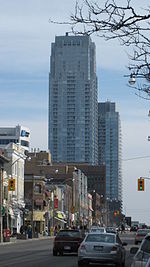Chaplin Estates

Chaplin Estates is a neighbourhood that covers the southwest portion of the Yonge and Eglinton area in Toronto, Ontario, Canada. It lies west of Yonge Street and is bounded by Eglinton Avenue to the north and Avenue Road to the west. The southern boundary is Chaplin Crescent, which runs parallel to the former Beltline Railway line, now the Beltline Trail, a scenic walking and biking trail. A portion of the Toronto Transit Commission's Yonge-University-Spadina subway line runs above ground along the eastern fringe of Chaplin Estates, and transit access is provided through Davisville station and Eglinton station. Chaplin Estates is one of the wealthiest neighbourhoods in Toronto.
Excerpt from the Wikipedia article Chaplin Estates (License: CC BY-SA 3.0, Authors, Images).Chaplin Estates
Colin Avenue, Old Toronto
Geographical coordinates (GPS) Address Nearby Places Show on map
Geographical coordinates (GPS)
| Latitude | Longitude |
|---|---|
| N 43.7 ° | E -79.4 ° |
Address
Colin Avenue 41
M5P 1A3 Old Toronto
Ontario, Canada
Open on Google Maps










